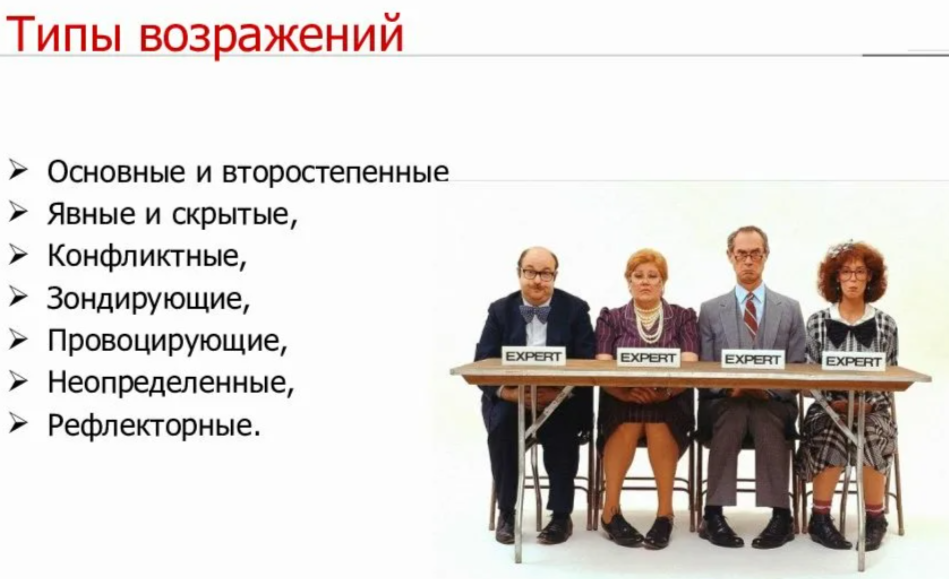Receiving objections from clients is an inevitable part of sales. However, the ability to handle them correctly and effectively can be key to achieving successful deals. In this article, we'll explore what objection handling is, why it's important, the different types of objections, and how to properly apply techniques and strategies to overcome client objections.
Why Handle Objections: Overcoming Key Barriers to a Successful Deal
Handling customer objections is an integral part of the sales process, and it's important to understand why handling them is so crucial. Transitioning from objection to customer confidence is key to a successful sale. Let's take a closer look at why this is important and the benefits it brings to both the seller and the buyer.
Overcoming doubts and uncertainty
One of the main reasons why handling objections is so crucial is to overcome any doubts and uncertainties a client may have. During the purchasing process, clients may encounter misunderstandings, unfamiliarity with certain details, or simply doubts about their choice. Handling objections effectively allows you to clarify the situation, provide additional information, and reassure the client of their decision.
Strengthening trust and relationships
Objection handling also serves as a tool for building trust and building relationships between the salesperson and the client. When the client sees that the salesperson isn't just trying to make a sale, but truly understands their needs and strives to solve their problems, this creates a positive experience and impression. Objection handling allows the salesperson to actively listen to the client, show interest in their opinions, and demonstrate that the sale isn't the only goal.
Highlighting the benefits and value of the product
When a customer raises objections, it gives the salesperson an opportunity to elaborate on the benefits and value of the product or service. Addressing objections allows the salesperson to clearly explain how the offer can meet their needs and solve their problems. The salesperson can provide additional arguments, facts, and data that support the product's value and convince the customer of their choice.
Risk reduction and client comfort
Many clients are afraid of making the wrong choice and risking their money. Objection handling helps mitigate this risk by providing additional information and compelling arguments. This creates a comfortable experience for the client, making them more confident in their decision. When clients see that their objections have been addressed and refuted with sound arguments, they feel more secure and more inclined to complete the transaction.
Increasing the likelihood of a successful transaction
Ultimately, handling objections increases the likelihood of a successful deal. A client who feels their doubts have been addressed and their needs are addressed is much more likely to close the deal. Effective objection handling helps move the client from a state of doubt and hesitation to a state of confidence and positive expectations.
Reasons for Objections: Uncovering Their Roots for Successful Sales
Objections inevitably arise when interacting with clients. However, to effectively address them, it's essential to understand their underlying causes. Let's take a closer look at the possible sources of objections and the factors that contribute to their emergence.
Lack of customer awareness
One of the main causes of objections is the client's lack of understanding of the product or service. When a client lacks complete and accurate information about the value they can gain, the benefits they will receive, and the problems the deal will solve, they develop doubts. Therefore, providing the client with all the necessary information about the product or service is an important step in preventing objections.
Fear of making the wrong choice
Many customers are afraid of making the wrong choice and wasting money. This fear can stem from a lack of confidence in their knowledge or experience. Customers may fear that the product won't meet their expectations or solve their problems. Therefore, it's important for salespeople to create an atmosphere of trust and reassure customers that their concerns are unfounded.
Comparison with alternatives
Customers often explore several options before making a choice. Comparing them to alternatives can leave them unsure whether your offer is the best. They may ask about the differences between products and compare prices and features. It's important to provide customers with a clear understanding of the uniqueness and benefits of your offering.
Fear of change
Even if your product offers significant benefits, customers may be wary of changing their routine or habits. They may worry that a new product will require adaptation, learning, or even lifestyle changes. It's important to address these fears and demonstrate how your product can integrate into their current lifestyle without added complexity.
No need
Another reason for objections may be a lack of need for the product or service. If the client doesn't see how your offer will solve their problems or meet their needs, they won't be interested in the deal. In this case, the salesperson's job is to clearly demonstrate the specific benefits the client will receive from working with you.

Types of Objections: Understanding the Diversity of Their Manifestations
During the sales process, clients may raise a variety of objections, and understanding the different types is key to successful customer service. Let's take a closer look at these objection types to learn how to recognize and effectively handle each one.
Major and Minor Objections
Primary objections are directly related to the product, service, or offer. These objections express customer doubts about the product's technical specifications, value, or suitability for their needs. Primary objections can be overcome by providing additional information, explaining the benefits, and sharing positive experiences from other customers.
Minor objections may be related to psychological factors, fears, prejudices, or client preferences. They may arise from personal beliefs, fear of change, or even simply uncertainty. Handling minor objections requires a more careful approach, as they may be less obvious.
Reasonable and unjustified objections
Valid objections are based on real data or facts. These may be specific problems or needs the customer sees and understands. Valid objections require clear reasoning and evidence that your product can solve these problems.
Unfounded objections can be caused by misunderstandings or incorrect information. The client may express doubts based on incorrect assumptions or outdated data. In this case, your task is to provide accurate information and demonstrate the additional benefits your product will bring.
Explicit and implicit objections
Explicit objections are expressed openly and clearly. The client directly expresses their doubts or questions about your proposal. This may be related to both technical and psychological issues. Addressing explicit objections occurs at a more open and direct level.
Hidden objections can be more subtle and unnoticeable. The client may not express them openly, but they can be revealed through their behavior, tone of voice, or even facial expressions. Identifying hidden objections requires attentiveness and observation. To address them, it's important to establish a trusting and comfortable relationship.

Techniques for handling objections
1. Listen to the client and try to understand
The first step in handling objections is to listen to the client. Listening allows you to identify their real concerns and questions. It's important to give them the opportunity to fully express their opinion.
2. Share your feelings
By showing your understanding and even sympathy for the client's objection, you create an atmosphere of trust and understanding.
3. Find out whether the objection you are facing is true or false.
Ask additional questions to understand how realistic and justified the client's objection is.
4. Ask about other objections
Clients often have multiple objections. By asking additional questions, you can identify them all and address them simultaneously.
5. Give an argument in favor of the product
Provide the client with specific arguments that can eliminate his fears and doubts.
6. Make sure you close the objection

7 steps to successful sales
During the sales process for products or services, situations arise where customers raise objections. It's important to take the necessary steps to resolve their concerns and establish trust. Let's take a closer look at 7 key steps that will help you overcome customer objections and ensure a successful outcome:
Attentive and active listening is one of the most effective methods for handling objections. Listen attentively and without interrupting, giving the client the opportunity to express their concerns and problems. Be polite and willing to help.
Clarifying questions — ask questions that will help uncover the true roots of the client's concerns. This will help you more accurately understand their needs and offer the most appropriate solution.
Respect the client's perspective – show the client that you respect their perspective and understand their opinions. Show empathy and compassion for their concerns or expectations, creating an atmosphere of mutual trust.
Revealing the benefits and value of your product – after you've identified the objections, explain the benefits and value of your offer. Highlight the features of your product or service that can solve the customer's problems or satisfy their needs.
Provide evidence and real-world examples – back up your claims with practical evidence: testimonials from satisfied customers, research, and successful product use cases. This will help build customer trust.
Finding a compromise solution – if the client continues to object or make demands, try to find a compromise. Be flexible and look for alternatives that will be satisfactory to both parties.
Monitor client feedback – monitor the client's reactions, especially when objections have been resolved and you are moving toward closing the deal. Find out how satisfied they are with the answers and solutions received. If new questions arise, be prepared to provide additional information or discuss the situation again.
Handling customer objections requires patience, communication skills, and a willingness to compromise. Each of these steps plays a vital role in developing trusting relationships and successful sales of goods or services.

Examples of successful handling of customer objections
Below are some examples of how to effectively handle customer objections.
Objection: “The price is too high.”
Answer: "Let me tell you about the additional benefits and features of our product that make it worth its price. This will allow you to get greater value and long-term benefits from your purchase."
Objection: “I already have another supplier.”
Answer: "Let me show you how our offer stands out from the crowd. We approach each client individually, guarantee high-quality products, and provide reliable post-purchase support."
Objection: “I doubt the quality of your product.”
Answer: "Let me provide you with additional information about our product: quality certificates, positive customer reviews, and independent test results. This way, you can be sure that our product meets the highest standards."
Objection: “I’m not sure this is right for me.”
Answer: "Let's discuss your needs and expectations in detail. I'm confident we'll find the optimal solution that will fully satisfy your requirements."
Objection: “I need to think.”
Answer: "Of course, no problem. I'm happy to provide you with additional materials and contact information so you can ask questions and get further clarification when you feel ready."
Objection: “I don’t see the need for this product.”
Answer: "Let me demonstrate how our product can solve specific problems, optimize your time, and improve the efficiency of your business. I'm confident you'll see significant benefits."
Question: “I’m afraid there won’t be enough time to implement this.”
Answer: "Let's review the potential challenges. We can offer you a step-by-step implementation plan that adapts to your pace and minimizes potential disruptions."
Question: “I’ve heard negative reviews about your company.”
Answer: "Let me clarify the circumstances and share information about our long-term client relationships, successful projects, and positive results. We always maintain a high level of service."
Question: “I’m just considering my options for now.”
Answer: "I completely understand your need to explore the options. Perhaps by learning more about your needs, I can identify the most suitable options for you to make an informed decision."
Question: "I don't have time to talk now."
Answer: "I value your time. If you can spare a few minutes, I can briefly present our proposal and demonstrate how it solves your problems. I can also provide my contact information or contact you at your convenience."
In every case, understanding and a willingness to adapt to the client's needs are key. By offering additional information or a more convenient way to communicate, you'll lay the groundwork for continuing the dialogue when the client is ready.

Conclusion
When interacting with clients, objections are unavoidable. However, the ability to effectively handle them plays a crucial role in achieving successful deals. Open listening, reasoned responses, and adapting to the client's needs and constraints—all these steps build trust and create the foundation for successful sales. Handling objections requires patience, empathy, and flexibility. Remember, every objection is an opportunity to demonstrate the value of your offer and help the client make an informed decision.







